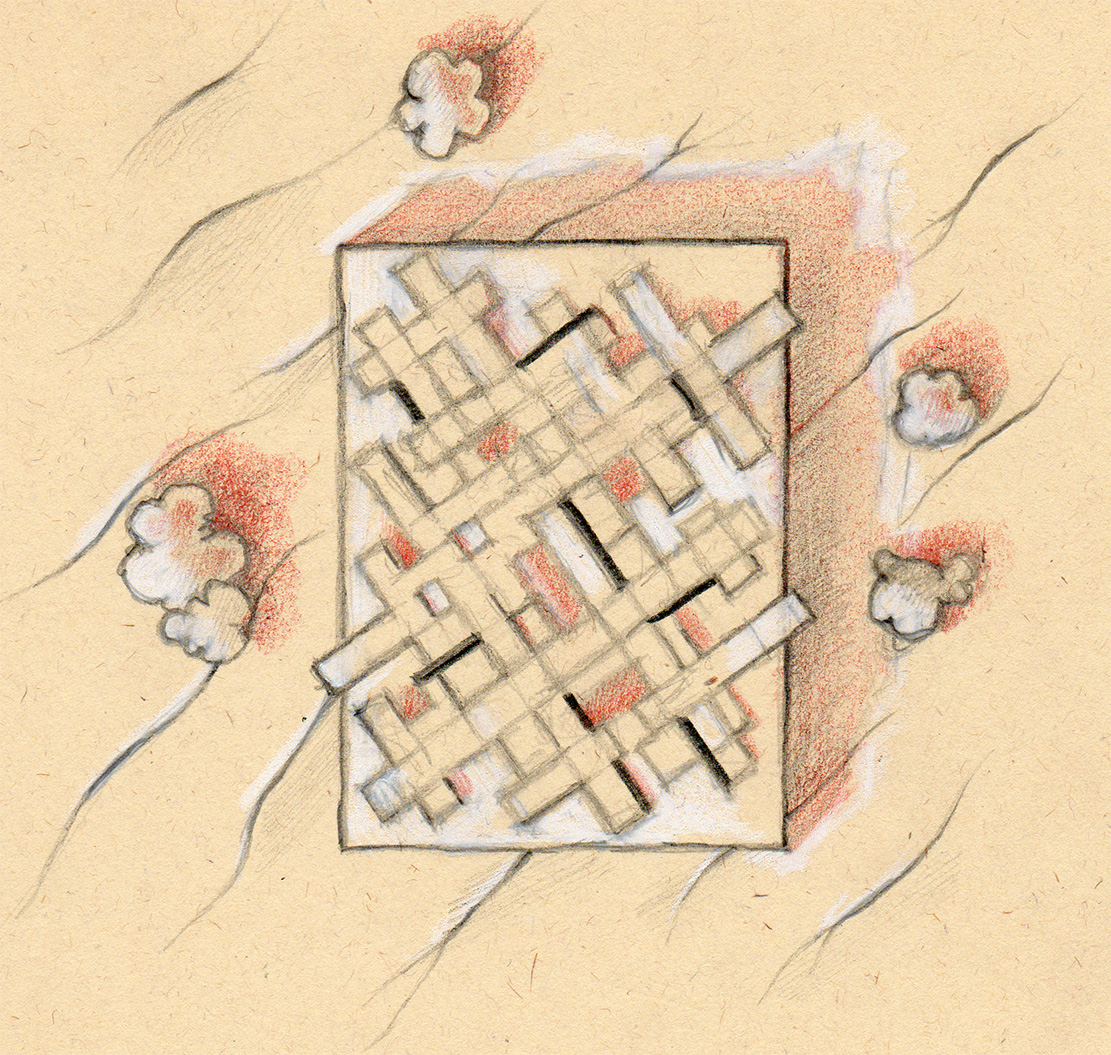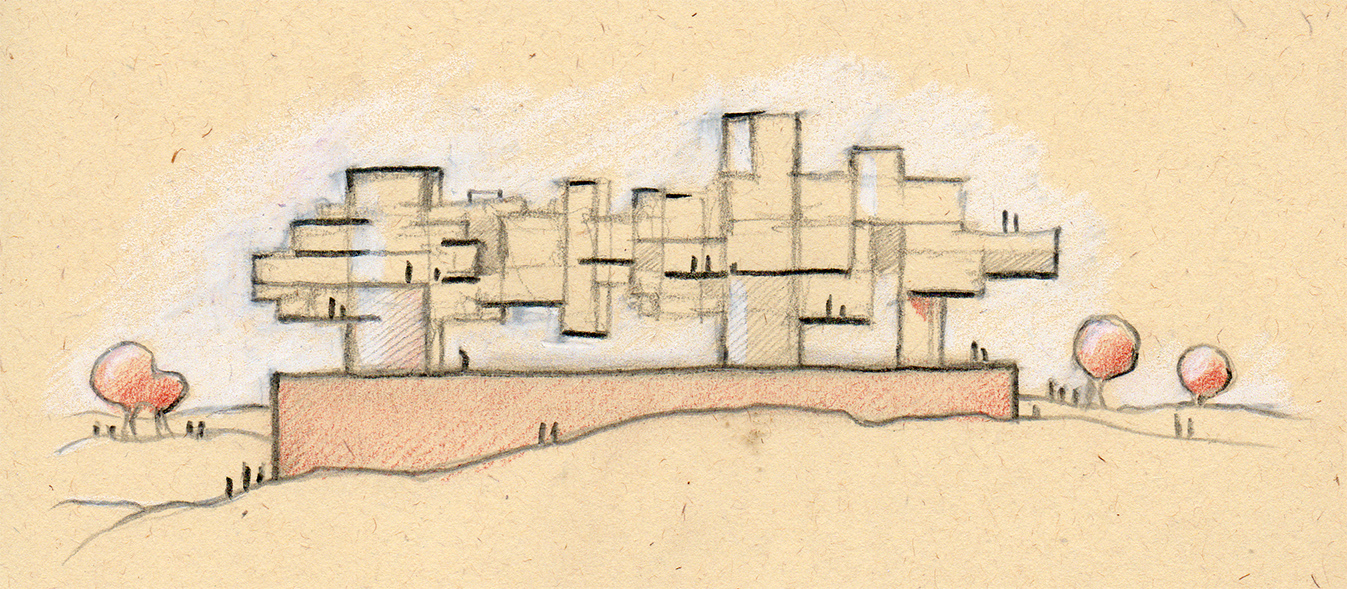【Discuss Section】
Kurt Vonnegut,Discuss Section Slaughterhouse-Five
Literary Architecture
Longtime readers of the Daily will remember Matteo Pericoli’s Windows on the World project, which featured his pen-and-ink drawings of the views from writers’ windows around the world. Matteo is also the founder of the Laboratory of Literary Architecture, an interdisciplinary project that looks at fiction through the lens of architecture, designing and building stories as architectural projects. In this new series, Matteo shares some of his designs and what they reveal about the stories they’re modeled on.

How can a horrific event, so monstrous it seems incomprehensible, be told? How does one even find the words to write about it? In the opening chapter of Slaughterhouse-Five, Kurt Vonnegut recounts his being unable to write a war book about the Dresden firebombing (February 13–15, 1945), which he survived: “there is nothing intelligent to tell about a massacre.”
That “failure” carries a weight. The over-five-thousand pages he had previously written are abandoned like a block of stone—history that cannot be told. But as soon as he abandons the idea of a linear and faithful historical reconstruction, Vonnegut frees himself from the huge weight, disconnects himself from the event, and takes off. “The next [book] I write is going to be fun.”
Two lines later and “the next book”begins: it tells the surreal story of Billy Pilgrim, a young man who lives “unstuck” from chronological time (his life events, whether far apart or close, interconnect in a perennial present), who connects with an alien civilization, and relives the Dresden bombings which he, just like Vonnegut, survived. Vonnegut also tells us how this new book will start—“Listen: Billy Pilgrim has come unstuck in time”—and how it will end—“Poo-tee-weet?”
Within Billy’s absurd story, we find many references to the historical and personal events Vonnegut mentioned in the beginning; we even meet the writer who, like a movie extra, appears here and there as a casual supporting element. “That was I. That was me.”
The structure of Billy’s imaginary and unhinged narrative leap must therefore lie upon (and rise from) the horrific weight of the unspeakable event. It must also contain points of contact between the unreal and the submerged stories. The stone foundation is as impenetrable as the idea of the Dresden bombing and it weighs on the landscape like all his years of research, memories, and attempts to understand the roots of such cruelty.
Billy Pilgrim’s story is instead a light, glass, and steel structure with its own geometry disconnected from that of the base, and with intersecting fragmentary volumes. A glass and steel cloud, suspended but properly anchored and supported by fin walls made of the same material as the base.
Once inside the cloud, we notice that there is order. Like Billy and Vonnegut’s aliens—who both perceive different events in time as nonchronological points in space—we visitors also understand that the fragmented spaces actually interpenetrate and that each event/space corresponds to another. Like Billy’s perception of time, space in the suspended structure is not linear. As we wander searching for order or meaning, we realize that every spatial instance contains the whole, the always.

In collaboration with Giuseppe Franco.
Search
Categories
Latest Posts
Amazon Prime Grubhub deal: Save $10 off orders of $20 or more
2025-06-26 06:50Sony to launch new flagship smartphone next week
2025-06-26 06:40Ed Sheeran is back on Twitter because what is dead may never die
2025-06-26 06:29Apple might ban Fortnite from iPhones for a year
2025-06-26 05:58The Sound and the “Furious”
2025-06-26 05:40Popular Posts
Best IPL deal: Save $80 on Braun IPL Silk·Expert
2025-06-26 05:33Google Pixel Buds Pro 2: $40 off at Amazon
2025-06-26 04:44Featured Posts
The 10 Most Anticipated PC Games of 2016
2025-06-26 06:52Colossal Western fires look ever more menacing, viewed from space
2025-06-26 06:37Flex your date
2025-06-26 06:15Trump doesn't seem to remember what his TikTok deadline actually is
2025-06-26 06:03No Time for a Negative Peace
2025-06-26 05:04Popular Articles
Samsung Unpacked stream is set for May 12, 2025
2025-06-26 06:03How freakish weather and fires came alive in the Western U.S.
2025-06-26 05:56Hulu's 'Woke' is the bold, irreverent comedy you need: Review
2025-06-26 04:55Trump doesn't seem to remember what his TikTok deadline actually is
2025-06-26 04:53Best IPL deal: Save $80 on Braun IPL Silk·Expert
2025-06-26 04:38Newsletter
Subscribe to our newsletter for the latest updates.
Comments (45278)
Steady Information Network
How to Easily Make iPhone Ringtones Using Only iTunes
2025-06-26 06:54Star Sky Information Network
HBO Max's 'Harley Quinn' cartoon is a sillier, gorier 'Birds of Prey'
2025-06-26 06:09Information Information Network
Lucid Air finally unveils what that 517
2025-06-26 06:08Unique Information Network
'New Girl' is the ultimate quarantine comfort watch
2025-06-26 05:35Heat Information Network
10 Tech Predictions for 2017
2025-06-26 04:50